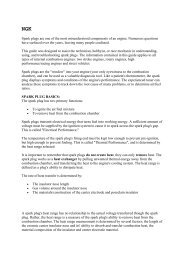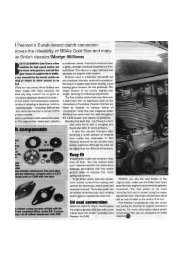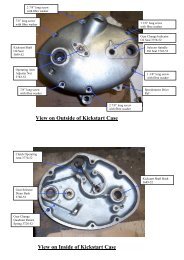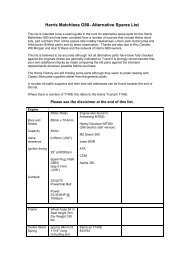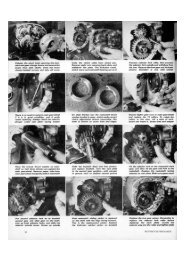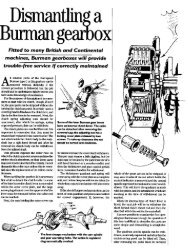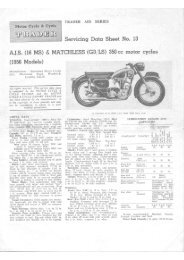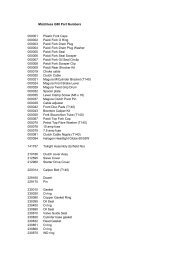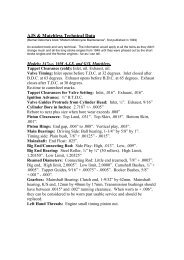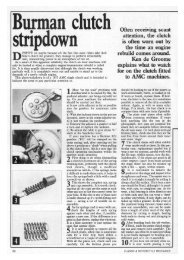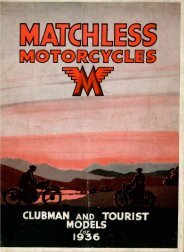THE ATLAS HYBRIDS - AJS and Matchless Archives
THE ATLAS HYBRIDS - AJS and Matchless Archives
THE ATLAS HYBRIDS - AJS and Matchless Archives
You also want an ePaper? Increase the reach of your titles
YUMPU automatically turns print PDFs into web optimized ePapers that Google loves.
AMC did not give this. Instead they ordered Norton to send them the 'factory money', closed Bracebridge<br />
Street down <strong>and</strong> moved production of all models to Plumstead. It would be a little naive to think that the<br />
two main points in this series of events, i.e. the troublesome engines at AMC <strong>and</strong> the moving of Norton<br />
production to Plumstead were unrelated. However it must be remembered that AMC were now fighting<br />
for survival. They already had a proven frame for scrambling, (the Featherbed would break below the<br />
headstock) but no reliable engine to power it, then all these Atlas engines <strong>and</strong> 'Roadholder' forks <strong>and</strong><br />
wheels mysteriously appeared at Plumstead!<br />
Engine Nos. 107388 to 124371 - Total approx. 5000<br />
In November 1963 a batch of 200 Norton 750 hybrids were leaving the Plumstead factory en-route to the<br />
American distributor, Berliner. When they arrived at their destination they would be the first delivery of<br />
the new 1964 Norton Atlas Scramblers <strong>and</strong> were the most powerful production desert-racers ever to be<br />
produced at that time. The prototype had already been thoroughly tested on the rough at Hawkstone<br />
Park by Chris Horsfield. This was the start of a four-year production run for the Atlas powered G.15<br />
series.<br />
1964 - Nos. 107388 to 110774 : Atlas Scramblers G.15C.S./N <strong>and</strong> G.15C.S./M : Approx. 1000 built<br />
All these machines used a new frame similar to the G.12 C.S. duplex type with bolt on rear subframe but<br />
were fitted with a redesigned malleable steel headstock machined to accept Norton forks <strong>and</strong> front<br />
wheel. The robust swinging-arm was of the <strong>Matchless</strong> type, but also redesigned to accept a Norton rear<br />
wheel.<br />
The arm pivoted on a hardened steel hollow spindle, the outside diameter of which ran in phosphorbronze<br />
'oilite' bushes pressed into large lugs on each side of the front of the fork. This spindle was<br />
supported by its centre portion in a sturdy single cast lug which was pinned <strong>and</strong> brazed to the vertical<br />
tube forming the rear section of the main frame, the spindle being locked in position by way of a cotter.<br />
The front forks used stanchions which were 2" longer than the Featherbed version <strong>and</strong> had special<br />
'Teledraulic' type two-way damping <strong>and</strong> external springs hidden by steel cover tubes in preference to<br />
rubber gaiters, along with st<strong>and</strong>ard Roadholder alloy sliders. The forward engine mounting lugs were<br />
positioned to accept the latest twin carburettor version of the Atlas engine. The frame/engine numbers<br />
followed the Norton system (as did all subsequent hybrids).<br />
The left side crankcase half was machined to take the AMC cast alloy primary chaincase <strong>and</strong> the<br />
gearbox shell was of the A.J.S./<strong>Matchless</strong> type with the lugs in a different position to the Featherbed<br />
shell. The scrambles petrol tank, latest type pear shaped oil tank <strong>and</strong> battery box were all <strong>Matchless</strong><br />
items <strong>and</strong> were painted in the AMC Cardinal Red of the 1961/62 G.12 series machines. (Note to<br />
restorers: apart from colour options offered by the distributor, this purple-red was the stock finish <strong>and</strong><br />
only two prototypes were in silver). The petrol tank used Norton transfers on the sides <strong>and</strong> had a single<br />
black coach-line outlined in white. A straight through exhaust system with slightly upswept ends <strong>and</strong> no<br />
silencers was employed.<br />
Contemporary photographs of a silver prototype sometimes showed the machine with the large AMC<br />
silencers. The factory used that same machine to test components for the intended touring model. The<br />
mudguards were in chrome <strong>and</strong> had a centre rib, which were similar to those used on the G.15/45 all<br />
<strong>Matchless</strong> model. This first batch also used non-folding footrests <strong>and</strong> the Lucas K2FC competition<br />
magneto. Subsequent batches had folding footrests <strong>and</strong> a st<strong>and</strong>ard K2F magneto. The reason for the<br />
change of magneto apart from cost was that it was very difficult to undo the pickup holder screws due to<br />
the close proximity of the gearbox. The machines came complete with a 12 volt lighting system.



